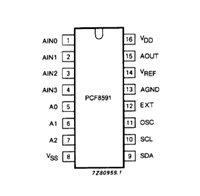ADSP-21160M/ADSP-21160N
Data Register File
ADSP-21160X
A general-purpose data register file is contained in each pro-
cessing element. The register files transfer data between the
computation units and the data buses, and store intermediate
results. These 10-port, 32-register (16 primary, 16 secondary)
register files, combined with the ADSP-2116x enhanced
Harvard architecture, allow unconstrained data flow between
computation units and internal memory. The registers in PEX
are referred to as R0–R15 and in PEY as S0–S15.
CLOCK
CLKIN
CS
BMS
BOOT
EPROM
(OPTIONAL)
4
CLK_CFG3–0
EBOOT
ADDR
DATA
CIF
LBOOT
BRST
3
IRQ2–0
ADDR31–0
ADDR
4
FLAG3–0
MEMORY/
MAPPED
DEVICES
DATA63–0
DATA
OE
TIMEXP
RDx
LINK
DEVICES
(6 MAX)
LXCLK
Single-Cycle Fetch of Instruction and Four Operands
WE
WRx
ACK
(OPTIONAL)
LXACK
ACK
CS
The processor features an enhanced Harvard architecture in
which the data memory (DM) bus transfers data, and the pro-
gram memory (PM) bus transfers both instructions and data
(see the functional block diagram 1). With the ADSP-21160x
DSP’s separate program and data memory buses and on-chip
instruction cache, the processor can simultaneously fetch four
operands and an instruction (from the cache), all in a single
cycle.
(OPTIONAL)
LXDAT7–0
MS3–0
TCLK0
RCLK0
TFS0
RSF0
DT0
PAGE
SERIAL
DEVICE
(OPTIONAL)
DMA DEVICE
(OPTIONAL)
SBTS
DATA
CLKOUT
DR0
DMAR1–2
DMAG1–2
CS
TCLK1
RCLK1
TFS1
RSF1
DT1
SERIAL
DEVICE
(OPTIONAL)
HOST
Instruction Cache
HBR
HBG
PROCESSOR
INTERFACE
(OPTIONAL)
The ADSP-21160x includes an on-chip instruction cache that
enables three-bus operation for fetching an instruction and four
data values. The cache is selective—only the instructions whose
fetches conflict with PM bus data accesses are cached. This
cache allows full-speed execution of core, providing looped
operations, such as digital filter multiply- accumulates and FFT
butterfly processing.
DR1
REDY
BR1–6
PA
RPBA
ID2–0
ADDR
DATA
RESET JTAG
6
Data Address Generators with Hardware Circular Buffers
Figure 2. Single-Processor System
The ADSP-21160x DSP’s two data address generators (DAGs)
are used for indirect addressing and provide for implementing
circular data buffers in hardware. Circular buffers allow efficient
programming of delay lines and other data structures required
in digital signal processing, and are commonly used in digital
filters and Fourier transforms. The two DAGs of the product
contain sufficient registers to allow the creation of up to 32 cir-
cular buffers (16 primary register sets, 16 secondary). The DAGs
automatically handle address pointer wraparound, reducing
overhead, increasing performance, and simplifying implemen-
tation. Circular buffers can start and end at any memory
location.
enabled, the same instruction is executed in both processing ele-
ments, but each processing element operates on different data.
This architecture is efficient at executing math-intensive DSP
algorithms.
Entering SIMD mode also has an effect on the way data is trans-
ferred between memory and the processing elements. In SIMD
mode, twice the data bandwidth is required to sustain computa-
tional operation in the processing elements. Because of this
requirement, entering SIMD mode also doubles the bandwidth
between memory and the processing elements. When using the
DAGs to transfer data in SIMD mode, two data values are trans-
ferred with each access of memory or the register file.
Flexible Instruction Set
The 48-bit instruction word accommodates a variety of parallel
operations for concise programming. For example, the proces-
sor can conditionally execute a multiply, an add, and subtract,
in both processing elements, while branching, all in a single
instruction.
Independent, Parallel Computation Units
Within each processing element is a set of computational units.
The computational units consist of an arithmetic/logic unit
(ALU), multiplier, and shifter. These units perform single-cycle
instructions. The three units within each processing element are
arranged in parallel, maximizing computational throughput.
Single multifunction instructions execute parallel ALU and
multiplier operations. In SIMD mode, the parallel ALU and
multiplier operations occur in both processing elements. These
computation units support IEEE 32-bit single-precision float-
ing-point, 40-bit extended-precision floating-point, and 32-bit
fixed-point data formats.
Rev. C
|
Page 5 of 60
|
February 2013






 STM32F030C6芯片介绍:主要参数分析、引脚配置说明、功耗及封装
STM32F030C6芯片介绍:主要参数分析、引脚配置说明、功耗及封装

 PCF8591数据手册解读:参数、引脚说明
PCF8591数据手册解读:参数、引脚说明

 一文带你了解ss8050参数、引脚配置、应用指南
一文带你了解ss8050参数、引脚配置、应用指南

 深入解析AD7606高性能多通道模数转换器:资料手册参数分析
深入解析AD7606高性能多通道模数转换器:资料手册参数分析
